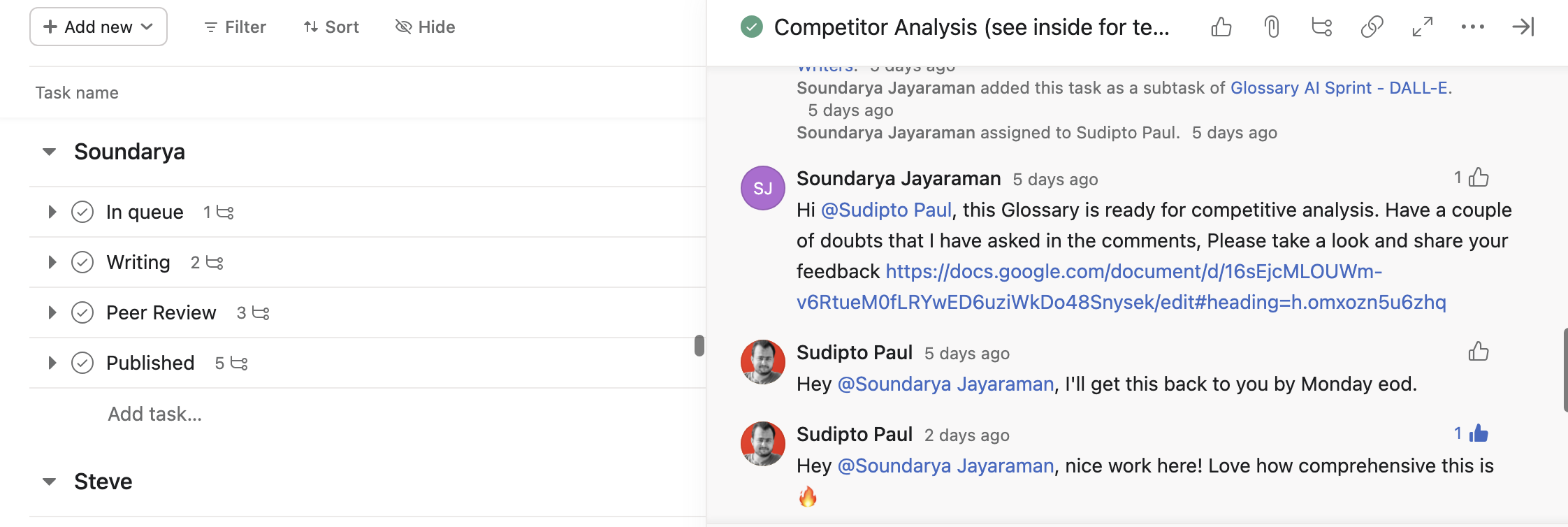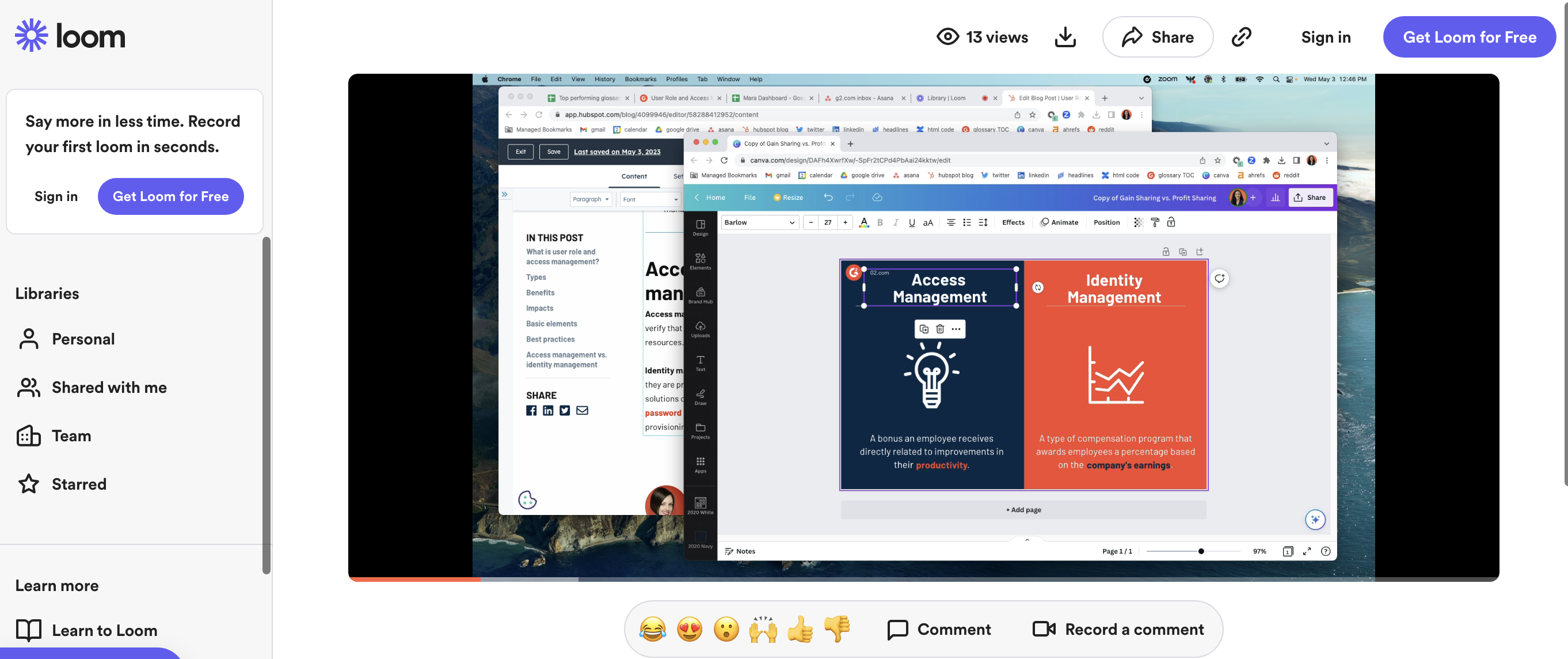Without effective internal communication (and probably coffee), any business would grind to a halt.
Think about it: multiple teams spread across time zones and countries, each with different ideas and various projects. Internal communication is crucial for everybody to work toward a single goal-the company's success. It ensures that information flows seamlessly within an organization and empowers employees to feel connected, informed, and valued.
And just like there is more than one way to bake a cake, there are a lot of ways to communicate internally. You can email, Slack, Zoom, use employee communication tools to share company updates, or meet face-to-face, like in old times.
But it's important to remember the internal communication tool you choose affects the reception of your message and your audience’s reaction. For example, sending messages via an instant messaging app to a person who responds best to in-person interaction may misfire.
To save you all the trouble and help you choose the best one to convey your message across the board, we’ll walk you through all the best internal communication methods.
Top 12 internal communication methods
- Face-to-face meetings
- Email correspondence
- Texting and instant messaging apps
- Project management tools
- Phone calls
- Video conferencing
- Corporate intranet platform
- Employee newsletters
- Videos
- Bulletin boards or digital signage
- Memos
- Employee engagement tools
4 types of internal communications
Before we delve deeper into different internal communication methods, let’s look at various types of internal communication. Understanding this helps you select the best internal communication tool for your message.
1. Vertical communication and its types
Vertical communication flows up and down between people at different levels of the organization’s hierarchy. It usually happens in two ways:
Management-to-employees communication (top-down)
Have you got an email from your manager on targets for the quarter or an upcoming deadline? Well, that’s top-down communication. It involves any communication subordinates get from higher-level executives.
Also referred to as downward communication, it is commonly used for sharing announcements, company policies, goals, guidance, performance feedback, and other essential management decisions or organizational changes.
Employee-to-management communication (bottom-up)
It’s the end of the month, and you send a report to management sharing team updates. That’s bottom-up communication. Also known as upward communication, it refers to the flow of information from subordinates to higher-level executives.
Upward communication is not just about sharing task updates. It helps employees provide feedback, suggestions, ideas, concerns, and opinions to managers or executives. Anonymous surveys, polls, and Q&A sessions are some effective ways to gather employee feedback and opinion on key organizational policies and decisions.
2. Horizontal communication (peer-to-peer communication)
Did you slack your teammate asking for their help with work? That’s horizontal communication. Many consider vertical communication to be the most important. However, much of the communication at work occurs horizontally among coworkers, with whom one doesn’t have a hierarchical relationship. Horizontal communication is an absolute must for coordinating tasks.
3. Formal and informal communication
Any internal communication can be formal or informal based on the communication channels and the information shared. Any use of official communication channels like emails, company websites, or written documents to convey official information is considered formal communication.
Interactions like casual face-to-face meetings with colleagues, watercooler chats, instant messaging, or gatherings during social events that don't necessarily have to be about the company or official policies are part of informal communication.
4. Crisis communication
This type of communication is about delivering important and accurate information to employees when the organization faces a crisis. Often, businesses have crisis communication guidelines that outline how executives should respond and communicate during a crisis.
Messages are shared across multiple official channels to apprise employees about the developing situation and how to keep them safe, mitigate risks and reduce impact. Examples include communication you might have received from management during the pandemic.
Explore how asynchronous communication methods like email and project comments fit into a modern internal comms stack.
Want to learn more about Internal Communications Software? Explore Internal Communications products.
Top 12 internal communication methods
With the emergence of remote and hybrid work, internal communication methods have increased.
72%
of business leaders believe effective communication increases their team’s productivity.
Source: Grammarly
Here are the most commonly used internal communication methods across businesses.
1. Face-to-face meetings
In-person meetings are one of the old-school methods of communicating directly with colleagues. These are often pre-arranged to discuss a relevant topic with all participants.
Whether they happen in large groups or between two people, it facilitates two-way communication and helps the meeting organizer discern if attendees understood clearly what’s being discussed. These meetings are also more memorable as they allow attendees to pick up on non-verbal cues and body language that are difficult to catch via text or other digital communication channels. As a result, such meetings help make decisions, resolve conflict, and fuel collaboration.
Now before you schedule a meeting, ask yourself a few questions so that it doesn’t end up in the “this meeting could have been an email” list. Meetings should be scheduled for things that cannot be solved asynchronously and require discussion to get clarification or resolution.
%20(3).png)
2. Email correspondence
I don’t know about you, but as a rule, I open my email inbox when I start my workday. It tells me if I need to address anything before I jump into my regular schedule.
Email is the most commonly used channel for communication in workplaces. It is fast, easy to use, and accessible even on mobile phones. While it's generally believed emails can be used to share any type of information, in all honesty, it doesn’t serve all purposes, and if used incorrectly, can slow us down.
When to send an email internally
- To send company-wide announcements that require all staff or multiple people within the team to receive the same message simultaneously
- To formally communicate decisions or request simple actions
- To confirm or schedule appointments
- To document important conversations
Learn how to write professional emails that get you the reply you need. Also, follow the best practices for emails so that your email doesn’t find itself waiting to be opened in the receiver’s inbox.
3. Texting and instant messaging apps
“I’ll Slack you the details” is another phrase that’s become common in workplaces in recent years.
Emails, in-person meetings, and conference calls all have their place. But instant messaging is the solution for ongoing collaboration and fast, real-time communication with teammates. It eliminates emails that linger in inboxes waiting for responses and needless back-and-forth phone calls.
Some people would say instant messengers waste time compared to other communication channels. Professional conversations can get off-topic and become people discussing their weekend plans.
When used correctly, however, texting provides coworkers with an outlet for immediate and informal communication. These tools allow users to search conversations, offer a distinctive user experience, and integrate with other enterprise applications like file sharing, among several other features. As a result, instant messengers like Slack and Microsoft Teams have become an essential part of work.
Best practices for instant messaging at the workplace
- Keep messages concise, clear, and to the point.
- Follow your company’s ground rules for instant messaging.
- Maintain a professional tone and use appropriate language.
- Use threaded conversations to avoid confusion.
- Be respectful of colleagues' working hours when initiating conversations.
- Avoid sending non-urgent messages when a colleague is out-of-office or away unless necessary.
- Exercise caution when discussing sensitive or confidential information through instant messaging.
4. Video conferencing and virtual meetings
Video conferencing is the virtual equivalent of being in a meeting. It has fast become an essential internal communication method with the emergence of remote and hybrid work cultures. Video conferencing brings teams together and enables face-to-face interactions regardless of their physical locations.
Furthermore, video conferencing tools provide features to record the meetings, allowing attendees to refer back and review important points and share them with other stakeholders.
Here are some instances when it is advantageous to have video conferencing, especially if you have team members working from multiple locations:
- Team meetings
- Global town hall events
- Project kick-off events
- Major status updates and progress reports
- Brainstorming sessions
- Training and workshops
- Team building sessions
- One-on-one sessions
5. Phone calls
Sure, we love emails and instant messaging over calls. However, when the issue you want to discuss is complex, sensitive, or important, it's better to talk with the concerned stakeholders directly. And when you can’t meet them for a face-to-face meeting, your next best alternative is to make that phone call. It’s more personal. You can ask a lot of follow-up questions and clear everything at once. It also resolves issues faster.
Audio conference calls are also a good option for multiple people simultaneously.
6. Collaboration and project management tools
A major part of internal communication happens between colleagues collaborating on projects. Online project management tools like Trello, Asana, or Jira can help with that.
They enable teams to manage tasks, assign responsibilities, track progress, and communicate about specific projects. It cuts down time spent on meetings and calls to get progress updates.
Below, I have used a project management app to assign tasks and the required file to my teammate. We communicated within the tool, avoiding confusion and backlogs. This task board also helps my manager keep track of all my assigned tasks' progress.

Source: Asana
7. Corporate intranet platforms
Your company intranet is the perfect place for storing and sharing business knowledge, news, updates, and documents. It doesn’t matter if the information is urgent or collecting dust. If your employees can use it as a centralized hub for knowledge sharing and communication, having the information on your company intranet can't hurt.
G2, for instance, has its intranet that serves as a repository of resources from multiple teams that the entire company can access. They also act as discussion forums.
To get the best out of your company’s intranet platform, set some ground rules and advise employees on how to use and what to share on it.
8. Employee newsletters
Another company-wide digital communication channel is the employee newsletter. It delivers essential company news and is designed to keep workers up-to-date, engaged, and aligned with company goals.
A typical company newsletter includes company news, project updates, upcoming events, job postings, team member updates, company milestones, customer stories, and anything that engages employees. A good employee newsletter nurtures employee engagement, promotes company culture, celebrates achievements, and builds a sense of community in the workplace.
Related: Learn how to create an internal newsletter that grabs attention.
9. Videos
When we think of videos as a communication tool, we think about marketing videos and branding campaigns. However, videos are effective employee communication tools too.
Pre-recorded videos are efficient for a variety of purposes, from sharing important corporate updates from leadership to training videos for new employees. Visual communication using videos grabs immediate attention and delivers the message quickly and clearly.
For instance, my colleague made a video on creating the perfect Canva image that matches our brand guidelines. This helped us avoid several back-and-forths for further clarifications and saved time.

Source: Loom
10. Bulletin boards and digital signage
Traditionally, bulletin boards were the place for sharing official company updates, events, policies, and safety information. Some companies even used bulletin boards to share employees’ personal events like birthdays and weddings.
Today, bulletin boards are getting replaced by digital signages. These electronic boards display announcements, company news updates, videos, graphics, and even real-time data if needed.
11. Memos
Business memorandums or memos are much less common these days. However, it is still one of the most important official communication methods in any business. Memos are more formal and professional and get more attention in the workplace.
Traditionally written memos were sent whenever an official announcement was to be made to a large group of employees. Today, written memos have been replaced by emails mainly because they are faster and easier to use.
To be clear, not all emails are memos. Only those that share official announcements formally are considered memos.
12. Employee engagement tools
Employee engagement tools are an essential internal communication channel that human resource departments can leverage. Consider the value of periodic employee pulse surveys on work processes and the work environment. Such surveys can help executives prioritize action items to address employee concerns.
Employee engagement tools help organizations solicit and track employee feedback, recognize their achievements, and promote a positive work environment. Moreover, these tools often include features such as news feeds, announcements, and personalized notifications, ensuring employees stay informed about company updates, events, and essential information for their personal growth.
Top 5 employee engagement tools
*These are the five leading employee engagement software from G2’s Summer 2023 Grid® Report.
How to build an internal communication strategy
Every organization needs an internal communication plan that provides high-level guidance on how employees can effectively talk, write, interact, and collaborate. A lack of a clear internal communication strategy can lead to miscommunication, misinformed employees, and falling productivity.
To avoid this, follow these steps and build your internal communication strategy:
Assess your current strategy
Evaluate your current internal communication methods. What channels are you using for internal communication? Are they effective? Are they promoting your company’s values and culture?
Conduct surveys or interviews with employees to identify strengths, weaknesses, and areas that require improvement in your existing communication strategy. Try getting their insights on the following questions:
- Do all employees have access to the information they need?
- Do they need more information or transparency from executives to feel more engaged?
- Do they get information they don’t need sometimes?
- Is there an information overload?
- What channels are most useful, and what doesn't help?
- And is there any problem with a particular channel of communication?
This feedback helps you understand the improvements needed in your internal communication strategy.
Define your audience
Many organizations make the mistake of thinking their employees are a homogenous group when communicating internally. However, organizations have people from different backgrounds, ages, and cultures with different viewpoints, values, and attitudes toward work at different levels and departments.
So, it’s important to understand the different employee segments within your organization. Consider their roles, teams, locations, and communication preferences. This helps you determine the right message and channel for multiple employee segments.
Related: Learn how to build strong employee relations and ensure employees are happy at work.
Define your goals and strategies
Analyzing your current internal communication strategy and audience helps you set the objectives for your new internal communication plan. Decide what needs to be improved and strategies you can use to do it.
For instance, your employee feedback shows they generally require more communication from C-suite executives on company-wide new business initiatives for the quarter.
Think about channels, messages, and strategies that can fill this gap. You can have an optional quarterly or monthly meeting to explain new initiatives to all interested employees. Or you can share such initiatives on dedicated forums on the company intranet and employee newsletter.
Similarly, strategize internal communication methods for various communication needs of your employees. Create personalized digital spaces and channels for different employee segments to connect and collaborate.
Create internal communication guidelines
Once you have all your internal communication strategies and tools in place, create a guidebook that all employees can refer to for workplace communication. This guide should provide:
- A broad idea of tools and channels employees can leverage for different types of internal communication.
- Basic rules on when to use which communication tool, expectations and considerations when using those tools, and best practices for better communication.
Most importantly, the guidebook should also explain the company culture and values your employees must remember while communicating with their colleagues.
Measure and modify
Implement metrics to measure the effectiveness of your internal communication efforts. Track engagement levels on discussion forums, open rates for newsletters, survey responses, or other relevant indicators to gauge the impact of your messages. Further, ask employees to share their opinions and concerns. Listen to their feedback, and respond promptly.
If a specific internal communication method isn’t working, find out why and try to improve it. Remember, the way we communicate keeps changing. So it’s not uncommon to modify your internal communication plan as and when needed. But keep your employees informed when you revise it.
8 internal communication best practices
Here are internal communication best practices that will make the workplace more efficient:
- Share timely updates on important projects, initiatives, and organizational changes.
- Tailor your message to suit different audiences while considering their roles, responsibilities, and information needs.
- Select the most appropriate communication channels for specific messages and audiences.
- Keep your messages simple and maintain a respectful tone.
- Ensure consistent messaging across different communication channels and departments.
- Gather employee feedback regularly.
- Provide training and resources to enhance employees' communication skills.
- Establish metrics to measure the effectiveness of internal communication efforts.
Build bridges
In today’s age of interconnectedness, there are real benefits and financial rewards to doing internal communication right. Good internal communication creates an open, thoughtful, continuous, and two-way dialogue with employees. It enhances collaboration and improves productivity.
Choosing the right internal communication method to share information in the workplace is everybody’s responsibility. Whether chatting with a coworker about a project or asking your boss for a promotion, it helps to rethink the method you will use to communicate it.
Want to explore more? Learn about the communication channels your business needs to succeed.

Soundarya Jayaraman
Soundarya Jayaraman is a Content Marketing Specialist at G2, focusing on cybersecurity. Formerly a reporter, Soundarya now covers the evolving cybersecurity landscape, how it affects businesses and individuals, and how technology can help. You can find her extensive writings on cloud security and zero-day attacks. When not writing, you can find her painting or reading.
